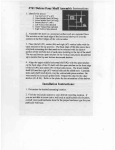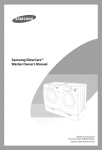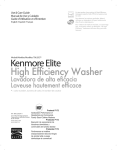Download Maytag MGR8674AB0 Operating instructions
Transcript
IN,=;TALLATI()N IN,c;TRUCTIONS FOR AUTOMATIC WASHERS PLEASE READ All Installation Instructions and Requirements Before Installing. FOR YOUR SAFETY AND THE PROPER OPERATION OF YOUR NEW WASHER, THE WASHER MUST BE INSTALLED IN ACCORDANCE WITH ALL THE INSTALLATION REQUIREMENTS. REMOVE CARDBOARD RETAINER FROM INSIDE WASHER. IT CONTAINS WATER FILL HOSES, DRAIN HOSE, TIE STRAP, LITERATURE AND PARTS BAG. SAVE LITERATURE FOR FUTURE REFERENCE. TOOLS REQUIRED: _4"OPEN END WRENCH PLIERS AND/OR VICE GRIPS %8"HEX HEAD NUTDRIVER RETAPE DOOR. CAUTIONS _1_ OPERATING READ OPERATIONS WASHER. MANUAL BEFORE _I_DO NOT CONNECT WASHER TO POWER SOURCE UNTIL INSTALLATION IS COMPLETED. P/N 35-4833-2 __ _ LOCATEAREA PROOF WASHER THATINCAN DRYSUPPORT WEATHERWEIGHT OF FULL WASHER. _ POWER MUST GROUNDED 120V AC OUTLET 60 HZ. DO NOT BE USE AN EXTENSION CORD. INSTALLATION INSTRUCTIONS PLEASE READ ._11Installation Instructions and Requirements Before Installing. 1, REMOVESHIPPING BASE NOTE; DO NOT LOWER OR RAISETHE WASHER BYTHE BACKGUARD. a. STEP ___ INSTALL WATER FILL HOSES Position corner posts on floor as shown (step one). b. Carefully lay washer on its back on top of the corner posts. NOTE: A small amount of water may run from the pump due to factory tests. c. Pop plastic loose from screw located between the back feet, or remove screw entirely with a _," Hex Head Nutdriver. d. Pull plastic base away from back feet. e. Grasping plastic base on sides pull downward to release front feet from slots and toward you to remove base. f. g. _'_1 WATER CONNECTIONS-- -.. COLDWATERINLET Discard base. (Base can be recycled.) RETURN WASHER TO UPRIGHT POSITION. RUBBER ,_,_,__ / Position the Hose Clamp over the end of the Drain Hose. Push the Drain Hose on to the Pump Outtet of the Washer. Be sure to position the hose in the direction of the standpipe, squeeze the clamp ears with pliers and move clamp toward washer so as to clamp hose securely to pump outlet. INSTALL WASHER WATERFILLHOSES 2. INSTALL DRAIN HOSE 3. =" - _r_------_ HOTWATERINLET WATER FILL HOSE Place a flat rubber washer in one end of each of the water fill hoses provided, making sure the washers are pushed in tightly. Attach the hose end with the flat washers to the water connections. Hot and cold connections are identified by H & C stamped in the cabinet, and "HOT" printed on the hose. Tighten hose connections by hand, until snug, and then another % turn with sTEP _ DRAIN INSTALL DRAIN HOSE HOSE O STEP _ REMOVE SHIPPING BASE FRONT FEET = BACKGUARD CARTON (STACKED T COR ON EACH jf OST OTHER) (I)CARTeN _ CORNER B (ONLY ,_pONETOAWASHER) :. / Y PUMP OUTLET POST_ 2. IN;TALLATION INSTRUCTIONS PLEASE READ All Installation 4. ADJUST LEVELING FEET Instructions b. Make sure rear feet move up and down freely, c. d. as possible. Place washer in final operating position, Tilt machine forward until rear of cabinet is approximately 4 inches off the floor, turn the machine loose letting it fall on FINAL CHECKOUT y_ • ,OCKW,S,E, w,r,,,,os rOC.ECK,_ s_e_E Proceed as follows: Position your washer as close to its final operating location Before Installing. STEP_ I,AOJUSTtEVEUNGFEET Your washer is equipped with self stabilizing legs on the rear which automatically stabilize the unit. The front legs are threaded and can be adjusted up and down to level your unit. a. and Requirements tooK,u, root_A° the rear feet. This operation will cause the rear stabilizing feet to conform to the contour of the floor and seat them solidly, Rock washer with hands on opposite corners to check stability. - _'_ _1 LeG" • • '_i_ -_ . _,,I__IE__ s_L_.w, _=, ._ •• Plug the Are any • A protective plastk film may cover • This should be removed. " Start the washer in control panel.as per wash cycle, .. t,O,O_TUB _ 5. DRAIN HOSETO STANDPIPE C. While holding the adjusting STYLE A: Push thefoot cuffstill, on turn the gooseneck endlockout of the clockwise drain hose into the standpipe as far as possible. Do not seat drain hose and standpipe as an airtight seal will cause siphoning (fill problems). _. power cor, water lea_' into an outlet? s_Lc...- SE_',CE u,,_ until the _ocknut is tightened firmly against base. Repeat step 4d above. T,_ Operating Instructions. STEP_ AIIo-_ water to fill in machine until it reaches the bottom HOT AND GOLD FAUCETS _>._ c>-.__ "-_1_:::___._/_ must be used. wash basket. _ I I • provided. _ i(_ w_,s.E, NOTE: BE SURE THE DRAIN HOSE IS NOT TWISTED OR KINKED. 6. HOT AND COLD FAUCETS _ _--_ t ..... Push the screens and washers (provided in the parts bag) into the remaining ends of the water hoses. Attach the water hoses to the hot and cold faucets. BE SURE ROT WATER INLET IS CONNECTED TO HOT WATER FAUCET. Tighten by hand until snug, and then a _ turn with pliers. DO NOT OVERTIGHTEN. Turn on faucets and check for leaks. Tighten to stop leaks, if necessary. Are there any kink., in hoses? eveident? (IF MACHINE IS NOT STABLE) freely on the threads. a. Loosen the locknuts on each leg, making sure they turn b. When the machine is in place, screw front feet out of base against the floor until the washer is acceptably level across the front. BOTH: prevent dislodging, the drainbreak hose kit NOTE: To If you mustaccidental make an airtight seal, secure an anti-siphon to the standpipe, laundry tub or inlet hose with the TIE STRAP both front feet been tightened Have locknuts on and are foot pads in place? StEP_ D_A_N HOSE TODRA_ FRONT FOOT ADJUSTMENT FOR SIDETO SIDE LEVELING. STYLE B: Put the gooseneck end of the drain hose into the standpipe or laundry tub. The drain hose should fit loosely in your standpipe as there is a possibility of siphoning if it fits too tightly. Have all installadol requirements been observed? I row of holes in the To stop washer, pu in onwater timeris knob. the not levl with the bottom ra of holes all around the basket, readjus i ........... • • the leveling feet as required to level. Remove the water Putting washer int_ spin cycle. During spin check drain system for leaks and proper operation. IN,c;TALLATI()N REC!UIREMENTS PLEASE READ All Installation Instructions and Requirements Before Installing. GENERAL INFORMATION most plumbingcodes. In most cases where a tight connec- It is recommendedthat a qualified service technician install your washer, LOCATION INSTALLWASHERON A SOLID FLOOR, lion is demanded,an anti-siphon valve should be placed the drain hose to preventwater from siphoning from the in washer or facility during agitation. If required, an anti-siphon valve Part No.33-4294N is availablefrom your dealer or store. Woodfloor constructionsmay sometimes need to be reinforced to minimizevibration from unbalancedload situations. Carpetsand soft tile surfaces are also contributing factors in vibrationand/or tendency for a washer to moveslightly during spin cycle. Never install washer on a platform or weak support structure. DO NOTINSTALLTHEWASHERON A CARPETEDFLOOR. DO NOTINSTALL OR STORETHEWASHERwhere it will ELECTRICALREQUIREMENTS 1. Provide an individual 120 volt, 60 HZ, branch circuit with groundfor the washer.This circuit must be rated for 15 or 20 amperes, 2. Protect the washer's electrical circuit with a 15 or 20 ampere time delay fuse or circuit breaker. 3. Install in accordance with National ElectricalCode ant all local codes and ordinances. GROUNDINGINSTRUCTIONS be exposedto the weather.If it is ever exposed to water, have a qualifiedtechniciancheckit before using, Insta}}ationin any locationsubjectto freezingtemperatures is not recommended.If the washer must be installed in such a location,it should be thoroughly drained after each use as follows: The washer must be grounded.In the event of a malfunctior of breakdown, groundingwill reduce the risk of electrical shock by providinga path of least resistance for electric cu_ rent. The washer is equippedwith a power supply cord which ha a groundingconductor and three-pronggrounding plug. For proper grounding, the three-prong groundingplug must be plugged in an appropriatethree-prong grounded receptacle or outlet. See Figure #1. The receptacle must be properly installedand grounded in accordancewith the National Electrical Cocleand all local codes and ordinances. a. Turn off hot and cold water faucets, b. Disconnectboth water fillconnections at the faucets, Lowerthem to the floor, c. With the service cord connectedto the electrical outlet, rotatethe timer to the normal start of fill position and pull timer knob to start washer.Turnwater temperature selector switch to warm. FIG. 1 d. When water stops draining form the hoses, disconnect service cord. THREE PRONG GROUNDINGPLUG POWERSUPPLYCORD. e. Lowerthe drain hose to the floor and allow it to drain into a floor drain or shallow pan. , In below freezing temperatures,ice may form in the "fill" to melt before using the washer. flume. Raise the room temperature and allow time for the WATERSUPPLYREQUIREMENTS _" _ ice 1. Hot and cold water must be availableat a pressure between 25 and 125 P.S.I.at the machine, if less, it will take longer to fill and complete the cycle. 2. Shut-offfaucets with standard hose connectors should be available in both hot and cold water lines so that the water can be turned off when the washer is not in use. WARNING OREQUIVALENT (NEMA NO.5 15R) ELECTRICALHAZARD Improperconnection of the grounding conductor or the three-pronggrounding plug of the power supply cord may result in an electrical shock hazard.If there is any doubt as to whether the washer is properly grounded, have the installationchecked by a qualified electrician or service technician, DO NOTMODIFY THE PLUG PROVIDEDWITH THE WASHER - If the plug will not fit the outlet, have a proper outlet installed by a qualified electrician. Always turn the water off the washer is not in use, especially when vacationing, 3. The installation should be in accordancewith local plumbingcode requirements. DRAIN REQUIREMENTS A drain that will permit 23 gpm flow is requiredto evacuate the washer.The standpipe should have a 172in. minimum internal diameter APPROVED GROUNDlik TYPEWALLRECEPTACL to prevent siphoning. BEFORE OPERATING YOUR WASHER READ ALL SAFETY Tight connectionsbetween the drain hose and the drain (standpipe,etc.) are not recommendedsince they violate PRECAUTIONS LISTEDINTHEOPERATING INSTRUCTIONS 't







